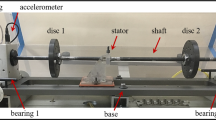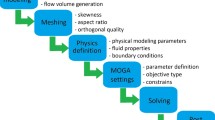Abstract
This study attempts to minimize vibrations while improving the aerodynamic performance of a UH-60A helicopter rotor using individual blade pitch control (IBC) with multiple harmonic inputs. A nonlinear flexible multibody dynamics analysis code, DYMORE II, integrated with a free-wake model, is used for rotor aeromechanics modeling and analyses. The rotor vibration index (VI) at advance ratios of 0.40 and 0.35 are minimized by 20% and 31%, respectively, when 2P and 3P actuation frequencies are applied, respectively; however, the IBC inputs for minimization of rotor vibration increase the rotor power by 2.66% and 2.34%, respectively. Therefore, IBC using combined 2P and 3P actuations is applied to achieve simultaneous vibration minimization and performance improvement (power reduction) of the UH-60A rotor at an advance ratio of 0.35. The best IBC pitch amplitudes and control phase angles for the combined 2P and 3P actuations are determined from the design optimization using a gradient-based optimizer, fmincon, based on the sequential quadratic programming in the MATLAB Optimization ToolBox. When 2P actuation with an amplitude of 2.15° and a control phase angle of 198° (2P/2.15°/198°) and 3P actuation with an amplitude of 1.21° and a control phase angle of 69.93° (3P/1.21°/69.93°) are applied in combination with the IBC input, the rotor VI decreases by 38.72%, whereas the rotor power slightly decreases by 0.11%. This study shows that an IBC with optimized multiple harmonic inputs can simultaneously minimize rotor vibration and improve rotor performance at a high-speed flight.
















Similar content being viewed by others
Data Availability
The numerical data used to support the findings of this study are included within the article.
Abbreviations
- CL :
-
Rotor lift coefficient
- CMx :
-
Rotor roll moment coefficient (positive for starboard down)
- CX :
-
Rotor propulsive coefficient
- F4P :
-
4P hub vibratory force, lb
- M4P :
-
4P hub vibratory moment, lb-ft
- M2Cd :
-
Section drag coefficient
- M2Cl :
-
Section lift coefficient
- R:
-
Rotor radius, ft
- αs :
-
Rotor shaft angle, deg. (positive for aft tilt)
- σ:
-
Rotor solidity
- Ω:
-
Rotation speed of a rotor, RPM or rad/s
- μ:
-
Advance ratio
References
Yu YH, Tung C, van der Wall BG, Pausder HJ, Burley C, Brooks T, Beaumier P, Delrieux Y, Mercker E, Pengel K (2002) The HART-II test: rotor wakes aeroacoustics with Higher-Harmonic pitch Control (HHC) inputs—the joint German/French/Dutch/US project. In: Proceedings of the 58th American Helicopter Society annual forum
Jacklin SA, Blaas A, Teves D, Kube R, Warmbrodt W (1994) Reduction of helicopter BVI noise, vibration, and power consumption through individual blade control. In: Proceedings of the 51st American Helicopter Society annual forum
Norman TR, Theodore C, Shinoda PM, Fuerst D, Arnold UTP, Makinen S, Lorber P, O’Neill J (2009) Full-scale wind tunnel test of a UH-60 individual blade control system for performance improvement and vibration, loads, and noise control. In: Proceedings of the 65th American Helicopter Society annual forum
Yeo H, Romander EA, Norman TR (2011) Investigation of rotor performance and loads of a UH-60A individual blade control system. J Am Helicopter Soc 56(4):1–18
Yeo H, Jain R, Jayaraman B (2016) Investigation of rotor vibratory loads of a UH-60A individual blade control system. J Am Helicopter Soc 61(3):1–16
Straub FK, Anand VR, Birchette TS, Lau BH (2018) Wind tunnel test of the SMART active flap rotor. J Am Helicopter Soc 63(1):1–16
Massey SJ, Kreshock AR, Sekular MK (2013) Coupled CFD/CSD computation of airloads of an active-twist rotor. In: Proceedings of the 31st AIAA applied aerodynamics conference
Johnson W (1994) Technology drivers in the development of CAMRAD II. In: Proceedings of the American Helicopter Society aeromechanics specialists’ conference
Saberi HA, Khoshlahjeh M, Ormiston RA, Rutkowski MJ (2004) RCAS overview and application to advanced rotorcraft problems. In: Proceedings of the American Helicopter Society fourth decennial specialists’ conference on aeromechanics.
Bir G, Chopra I (1994) Status of University of Maryland Advanced Rotorcraft Code (UMARC). In: Proceedings of the American Helicopter Society aeromechanics specialists’ conference
Bauchau OA (2006) DYMORE user’s manual. School of Aerospace Engineering, Georgia Institute of Technology, Atlanta
Park JS, Kim DH, Chae SH, Lee YL, Go JI (2019) Vibration and performance analyses using individual blade pitch controls for lift-offset rotors. Int J Aerosp Eng 2019:1–13
Kwon YM, Hong SB, Park JS, Lee YB (2022) Active vibration reductions of a lift-offset compound helicopter using individual blade pitch control with multiple harmonic inputs. Aircr Eng Aerosp Technol 94(6):994–1008
Park JS, Jung SN (2012) Comprehensive multibody dynamics analysis for rotor aeromechanics predictions in descending flight. Aeronaut J 116(1177):229–249
Park JS (2014) Multibody analyses for performance and aeromechanics of a rotor in low-speed flight. Aircr Eng Aerosp Technol 86(1):33–42
Park JS (2017) Validation of loads analysis for a slowed rotor at high advance ratios. Int J Aeronaut Space Sci 18(3):498–511
Park JS (2018) Validations of rotor load analysis using flexible multibody dynamics with multiple wake panels for low-speed flights. Int J Aeronaut Space Sci 19(4):863–877
Lim JW (2016) Consideration of structural constraints in passive rotor blade design for improved performance. Aeronaut J 120(1232):1604–1631
Anonymous (2006) Requirements for rotorcraft vibration, specifications, modeling and testing. Aviation Systems Command, Redstone Arsenal
Acknowledgements
This work was supported by Korea Research Institute for defense Technology Planning and advancement (KRIT) grant funded by the Korea government (DAPA (Defense Acquisition Program Administration)) (no. KRIT-CT-21-020, Development of Higher Harmonic Control (HHC) SW for Helicopter Vibration Reduction, 2023) (contribution rate: 50%). This study was supported by Basic Science Research Program through the National Research Foundation of Korea (NRF) funded by the Ministry of Education (2020R1I1A3071793) (contribution rate: 25%). This research was supported by Basic Science Research Program funded by Ministry of Science and ICT (2021R1A5A1031868) (contribution rate: 25%).
Author information
Authors and Affiliations
Corresponding author
Ethics declarations
Conflict of interest
The authors declare that there is no conflict of interest regarding the publication of this paper.
Additional information
Communicated by Haeseong Cho.
Publisher's Note
Springer Nature remains neutral with regard to jurisdictional claims in published maps and institutional affiliations.
Rights and permissions
Springer Nature or its licensor (e.g. a society or other partner) holds exclusive rights to this article under a publishing agreement with the author(s) or other rightsholder(s); author self-archiving of the accepted manuscript version of this article is solely governed by the terms of such publishing agreement and applicable law.
About this article
Cite this article
Park, JS. Simultaneous Vibration Reduction and Performance Improvement of Helicopter Rotor Using Individual Blade Pitch Control with Multiple Harmonic Inputs. Int. J. Aeronaut. Space Sci. (2024). https://doi.org/10.1007/s42405-024-00744-2
Received:
Revised:
Accepted:
Published:
DOI: https://doi.org/10.1007/s42405-024-00744-2




